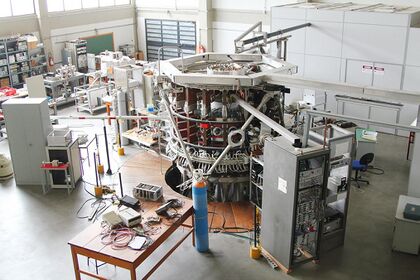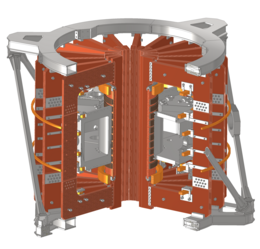Physics:Tokamak Chauffage Alfvén Brésilien
The Tokamak Chauffage Alfvén Brésilien (TCABR) is a tokamak situated at the University of Sao Paulo (USP), Brazil.[1][2] TCABR is the largest tokamak in the southern hemisphere and one of the magnetic-confinement devices committed to advancing scientific knowledge in fusion power.
History
TCABR was originally designed and constructed in Switzerland, at the École Polytechnique Fédérale de Lausanne (EPFL), and operated there from 1980 until 1992, under the name of Tokamak Chauffage Alfvén (TCA).[1] The main focus of TCA was to assess and enhance plasma heating with Alfvén waves. A couple of years later, the machine was transferred to USP, passing through an upgrade and adding Brésilien to its name. The operation of TCABR began in 1999.[1]
Properties
The TCABR plasma is made of hydrogen and has a circular format.[1][3] In general, its discharges are ohmically heated and the plasma current in TCABR reaches up to [math]\displaystyle{ I_P \leq 100\ \text{kA} }[/math]. The minor and major radii of TCABR are respectively [math]\displaystyle{ a=18.0\;\text{cm} }[/math] and [math]\displaystyle{ R=61.5\;\text{cm} }[/math], giving an aspect ratio of [math]\displaystyle{ A=R/a=3.4 }[/math]. The TCABR central electron temperature is around [math]\displaystyle{ k_{B} T_{e} \leq 650 \ \text{eV} }[/math] (i.e., [math]\displaystyle{ T_{e}\sim6\times10^{6}\;\text{K} }[/math]) and its mean electron density is [math]\displaystyle{ 0.9\leq\bar{n}_{e0}\leq3 }[/math], in units of [math]\displaystyle{ 10^{19}\;\text{m}^{-3} }[/math].[1][3] Other parameters of TCABR include the toroidal magnetic field, [math]\displaystyle{ B_{0}\sim1.1\;\text{T}, }[/math] the hydrogen filling pressure, [math]\displaystyle{ P_{H}\simeq3\times10^{-4}\;\text{Pa} }[/math], a discharge duration of [math]\displaystyle{ T_{D}\simeq100\;\text{ms} }[/math], and a steady-phase duration around [math]\displaystyle{ T\leq60\;\text{ms} }[/math].[1]
| Parameter | Symbol | Value |
|---|---|---|
| Plasma format | Circular | |
| Plasma composition | H | Hydrogen |
| Major radius | [math]\displaystyle{ R_0 }[/math] | [math]\displaystyle{ 61.5\text{ cm} }[/math] |
| Minor radius | [math]\displaystyle{ a }[/math] | [math]\displaystyle{ 18.0\text{ cm} }[/math] |
| Aspect ratio ([math]\displaystyle{ R_0/a }[/math]) | [math]\displaystyle{ A }[/math] | [math]\displaystyle{ 3.4 }[/math] |
| Plasma current | [math]\displaystyle{ I_p }[/math] | [math]\displaystyle{ \leq 100\ \text{kA} }[/math] |
| Central (or toroidal) magnetic field | [math]\displaystyle{ B_0 }[/math] | [math]\displaystyle{ \sim 1.1\ \text{T} }[/math] |
| Line-averaged electronic density | [math]\displaystyle{ \overline{n}_{e0} }[/math] | [math]\displaystyle{ 0.9\sim3\times10^{19}\ \text{m}^{-3} }[/math] |
| Central electronic temperature | [math]\displaystyle{ k_BT_{e0} }[/math] | [math]\displaystyle{ \sim 0.5\ \text{keV} }[/math] |
| Hydrogen filling pressure | [math]\displaystyle{ P_H }[/math] | [math]\displaystyle{ 1\sim 3\times10^{-2}\ \text{Pa} }[/math] |
| Discharge duration | [math]\displaystyle{ T_D }[/math] | [math]\displaystyle{ \simeq 100\ \text{ms} }[/math] |
| Duration of the steady phase | [math]\displaystyle{ T }[/math] | [math]\displaystyle{ \leq 60\ \text{ms} }[/math] |
Research program
The current purpose of the TCABR tokamak includes the study of Alfvén waves,[1][5][6] but is not restricted to it. Other research areas are (i) the characterization of magnetohydrodynamic (MHD) instabilities,[1][7] (ii) the study of high-confinement regimes induced by electrical polarization of external electrodes in the plasma edge,[3][7][8] (iii) the investigation of edge turbulence,[3][9] and (iv) the study of plasma poloidal and toroidal rotation using optical diagnostics.[1][10][11] The TCABR team is also associated with a theoretical group focused on investigating instabilities and transport barriers in tokamaks and dynamical systems.[12][13]
An upgrade in the TCABR is also being conducted.[14][15][16] A set of 108 RMP coils will be installed to control and study edge localized modes (ELMs). New shaping coils will be added, allowing great flexibility in plasma configurations (e.g. single null, double null, snowflake, and negative triangularity configurations).[16] The vacuum-vessel inner wall of TCABR will receive graphite tiles to decrease impurity deposition and energy loss in the plasma.
References
- ↑ 1.0 1.1 1.2 1.3 1.4 1.5 1.6 1.7 1.8 1.9 Galvão, R M O.; Amador, C H S.; Baquero, W A H.; Borges, F.; Caldas, I. L.; Cuevas, N A M.; Duarte, V. N.; Elfimov, A. G. et al. (2015). "Report on recent results obtained in TCABR". Journal of Physics: Conference Series 591 (1): 012001. doi:10.1088/1742-6596/591/1/012001. Bibcode: 2015JPhCS.591a2001G.
- ↑ 2.0 2.1 de Sá, Wanderley Pires. "TCABR Wiki". http://tcabrcl.if.usp.br/tcabrWiki/.
- ↑ 3.0 3.1 3.2 3.3 Grenfell, G. G.; Nascimento, I. C.; Oliveira, D. S.; Guimarães-Filho, Z. O.; Elizondo, J. I.; Reis, A. P.; Galvão, R. M. O.; Baquero, W. A. H. et al. (2018). "H-mode access and the role of spectral shift with electrode biasing in the TCABR tokamak". Physics of Plasmas 25 (7): 072301. doi:10.1063/1.5029561. Bibcode: 2018PhPl...25g2301G. https://doi.org/10.1063/1.5029561.
- ↑ Ronchi, Gilson (2017-03-02). Estudo de perfis de pressão no Tokamak TCABR (Doutorado em Física thesis) (in português). São Paulo: Universidade de São Paulo. doi:10.11606/t.43.2017.tde-22022017-125032.
- ↑ Ruchko, L.F.; Ozono, E.; Galvão, R.M.O.; Nascimento, I.C.; Degasperi, F.T.; Lerche, E. (1998). "Advanced antenna system for Alfvén wave plasma heating and current drive in TCABR tokamak". Fusion Engineering and Design 43: 15–28. doi:10.1016/S0920-3796(98)00260-9. https://doi.org/10.1016/S0920-3796(98)00260-9.
- ↑ Elfimov, A. G. (2009). "Kinetic ion effect on geodesic acoustic Alfvén modes in tokamaks". Physics of Plasmas 16 (3): 034501. doi:10.1063/1.3081547. Bibcode: 2009PhPl...16c4501E. http://dx.doi.org/10.1063/1.3081547.
- ↑ 7.0 7.1 Nascimento, I.C.; Kuznetsov, Yu.K.; Guimarães-Filho, Z.O.; El Chamaa-Neto, I.; Usuriaga, O.; Fonseca, A.M.M.; Galvão, R.M.O.; Caldas, I.L. et al. (2007). "Suppression and excitation of MHD activity with an electrically polarized electrode at the TCABR tokamak plasma edge". Nuclear Fusion 47 (11): 1570–1576. doi:10.1088/0029-5515/47/11/019. Bibcode: 2007NucFu..47.1570N. http://dx.doi.org/10.1088/0029-5515/47/11/019.
- ↑ Nascimento, I.C; Kuznetsov, Y.K; Severo, J.H.F; Fonseca, A.M.M; Elfimov, A.; Bellintani, V.; Machida, M.; Heller, M.V.A.P et al. (2005). "Plasma confinement using biased electrode in the TCABR tokamak". Nuclear Fusion 45 (8): 796–803. doi:10.1088/0029-5515/45/8/005. Bibcode: 2005NucFu..45..796N. https://doi.org/10.1088/0029-5515/45/8/005.
- ↑ Guimarães-Filho, Z.O.; Caldas, I.L.; Viana, R.L.; Kurths, J.; Nascimento, I.C.; Kuznetsov, Yu.K. (2008). "Recurrence quantification analysis of electrostatic fluctuations in fusion plasmas". Physics Letters A 372 (7): 1088–1095. doi:10.1016/j.physleta.2007.07.088. Bibcode: 2008PhLA..372.1088G. https://doi.org/10.1016/j.physleta.2007.07.088.
- ↑ Severo, J.H.F; Nascimento, I.C; Tsypin, V.S; Galvão, R.M.O (2003). "Plasma residual rotation in the TCABR tokamak". Nuclear Fusion 43 (10): 1047–1056. doi:10.1088/0029-5515/43/10/005. Bibcode: 2003NucFu..43.1047S. https://doi.org/10.1088/0029-5515/43/10/005.
- ↑ Severo, J H F.; Canal, G. P.; Ronchi, G.; Andrade, N. B.; Fernandes, T.; Ikeda, M. Y.; Collares, M. P.; Galvão, R M O. et al. (2021). "Overview of plasma rotation studies on the TCABR tokamak". Plasma Physics and Controlled Fusion 63 (7): 075001. doi:10.1088/1361-6587/abf955. Bibcode: 2021PPCF...63g5001S. https://doi.org/10.1088/1361-6587/abf955.
- ↑ Marcus, F. A.; Caldas, I. L.; Guimarães-Filho, Z. O.; Morrison, P. J.; Horton, W.; Kuznetsov, Yu. K.; Nascimento, I. C. (2008). "Reduction of chaotic particle transport driven by drift waves in sheared flows". Physics of Plasmas 15 (11): 112304. doi:10.1063/1.3009532. Bibcode: 2008PhPl...15k2304M. https://doi.org/10.1063/1.3009532.
- ↑ de Sousa, Meirielen Caetano; Medeiros, Everton; Caldas, Iberê Luiz (6 June 2022). "Website of the Oscillation Control Group". http://web.if.usp.br/controle/.
- ↑ Santos, A.O.; Komatsu, W.; Canal, G.P.; Severo, J.H.F.; De Sá, W.P.; Kassab, F.; Ferreira, J.G.; De Andrade, M.C.R. et al. (2020). "Development of high-current power supplies for the TCABR tokamak". Fusion Engineering and Design 159: 111698. doi:10.1016/j.fusengdes.2020.111698. https://doi.org/10.1016/j.fusengdes.2020.111698.
- ↑ Canal, G. P. (6 June 2022). "An overview of the upgrade of the TCABR tokamak". 12th IAEA Technical Meeting on Control, Data Acquisition and Remote Participation for Fusion Research (2019). https://conferences.iaea.org/event/180/contributions/14417/attachments/7945/10412/ID525_Canal.pdf.
- ↑ 16.0 16.1 Canal, G. P. (6 June 2022). "Modernização do tokamak TCABR para estudos de supressão de ELMs por campos RMP". Comissão Nacional de Energia Nuclear, 1o Seminário Nacional de Fusão Nuclear (2021).. https://www.gov.br/cnen/pt-br/assunto/pesquisa-desenvolvimento-e-ensino-na-area-nuclear/copy_of_GustavoPaganiniCanalModernizaodoTokamakTCABRparaEstudosdeSupressodeELMsporCamposRMP_compressed1.pdf.
 |



